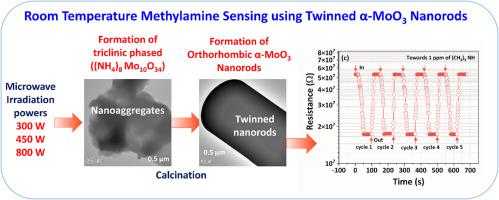Sensors and Actuators B: Chemical ( IF 8.4 ) Pub Date : 2021-09-16 , DOI: 10.1016/j.snb.2021.130759 Parthasarathy Srinivasan 1, 2 , John Bosco Balaguru Rayappan 1

|
Detection of methylamines is primarily associated with the quality assessment of seafood. In this context, we report chemi-resistive sensing of methylamine species using α-MoO3 nanorods synthesized via microwave technique. Investigations were carried out by varying the microwave irradiation power to 300, 450, and 800 W, respectively. Along with the effect of microwave power, the influence of the calcination process on the growth patterns has been emphasized. The un-calcined samples exhibited the formation of triclinic phased ammonium molybdenum oxide ((NH4)8 Mo10O34), whereas it gets transformed into orthorhombic phased α-MoO3 upon calcination. The surface morphology of the un-calcined samples showed the formation of aggregated nanogranular morphology, whereas the calcined samples disclosed the formation of densely populated nanorods. These nanorods were found to be grown with a controlled aspect ratio and twinning dislocations. The influence of twinning dislocations on the grain features and activation energy is reported. The calcined sample prepared at 450 W showed a maximum sensing response of S = 413 towards 200 ppm of trimethylamine (TMA, (CH3)3NH) at room temperature. The observed response towards TMA was 8 times and 5.5 times higher than that of the response observed for monomethylamine (MMA, (CH3) NH2)) and dimethylamine (DMA, (CH3)2NH)) respectively. Response/recovery times were found to be 23/12 s, 38/13 s, and 35/11 s towards 1 ppm of MMA, DMA, and TMA, respectively.
中文翻译:

使用孪晶 α-MoO3 纳米棒对甲胺物质进行化学电阻传感:晶粒特征、活化能和表面缺陷的作用
甲胺的检测主要与海产品的质量评估有关。在这种情况下,我们报告了使用通过微波技术合成的α-MoO 3纳米棒对甲胺物质的化学电阻传感。通过将微波辐射功率分别更改为 300、450 和 800 W 来进行研究。除了微波功率的影响外,还强调了煅烧过程对生长模式的影响。未煅烧的样品表现出形成三斜相化铵钼氧化物 ((NH 4 ) 8 Mo 10 O 34 ),而它转变成正交相化 α-MoO 3煅烧时。未煅烧样品的表面形态表明形成了聚集的纳米颗粒形态,而煅烧样品表明形成了密集的纳米棒。发现这些纳米棒以受控的纵横比和孪晶位错生长。报道了孪晶位错对晶粒特征和活化能的影响。在 450 W 下制备的煅烧样品在室温下对 200 ppm 三甲胺 (TMA, (CH 3 ) 3 NH)的最大传感响应为 S = 413 。观察到的对 TMA 的响应比对单甲胺 (MMA, (CH 3 ) NH 2 )) 和二甲胺 (DMA, (CH 3) 2 NH)) 分别。发现对 1 ppm MMA、DMA 和 TMA 的响应/恢复时间分别为 23/12 秒、38/13 秒和 35/11 秒。


























 京公网安备 11010802027423号
京公网安备 11010802027423号